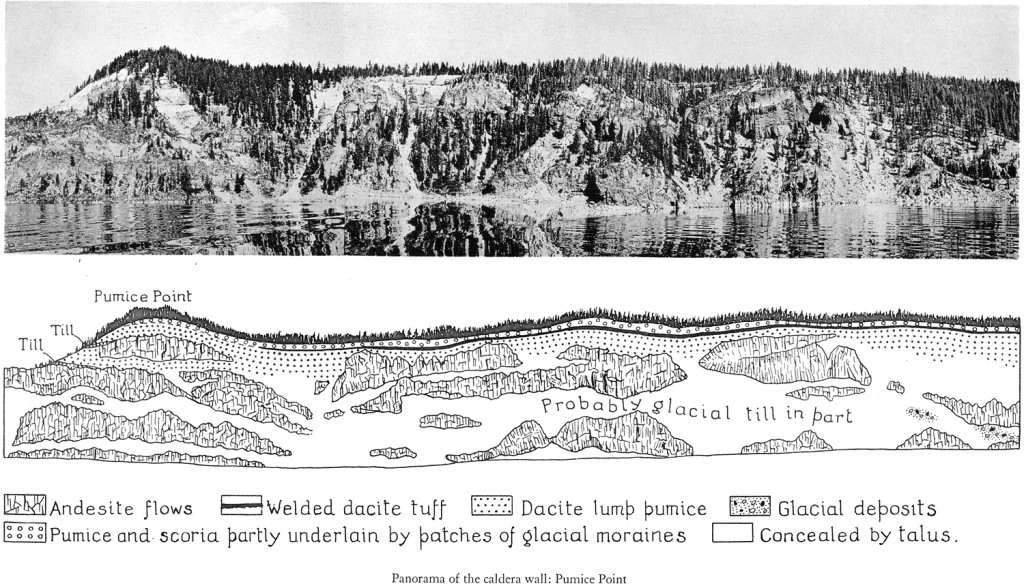Beyond Palisade Point, on the rise toward Rugged Crest, both the pumice and the welded tuff rest on the margin of the Cleetwood dacite, but they thin rapidly and are soon lost to view. Over the center of the Cleetwood lava there is no trace of either. Near the western edge of the lava, however, they reappear and are splendidly exposed along the Rim Road. Here the tuff rests directly on the red, oxidized crust of the Cleetwood lava and consists of incoherent, pumiceous lapilli, pink and orange at the base and paling upward to yellow and buff. Were it not that elsewhere similar deposits can be traced laterally into welded tuff, the identity of the material might be doubted. A short distance to the west, the varicolored, incoherent ejecta cross the highway and descend the caldera wall, still above the Cleetwood lava, but now separated from it by the usual layer of lump pumice. Once more, as the tuff falls in elevation, it takes on a welded appearance and simulates banded lava. From the west edge of the Cleetwood flow to the east base of Pumice Point, almost a mile away, the thickness of the cliff-forming, lava-like tuff varies between 20 and 50 feet, and in many places lenticular patches of andesite blocks are embedded in its lower part. The lump pumice below thickens to 100 feet, and locally shows a distinct stratification, as shown in plate IX B of Diller’s monograph. Finally, on the rise toward Pumice Point, the welded tuff thins, becomes incoherent, and disappears, though the lump pumice continues, as shown in the panorama, plate 27.
Plate 27. Panorama of the caldera wall: Pumice Point
Section south of the Wineglass. In the opposite direction from the Wineglass, the dacite tuff may be followed for 2 miles to the top of Skell Head, where it comes to an end. The underlying lump pumice, on the other hand, continues over the summit of Redcloud Cliff. Immediately the tuff rises southward from the Wineglass, the firmly welded character and the streaky alternation of gray and black obsidian bands disappear. Once more the deposit becomes a weakly compacted mass of buff, pink, and orange pumiceous dust, lapilli, and bombs. Mixed sparingly with the pumice are fragments of andesite. Throughout most of its course the deposit varies in thickness between 4 and 6 feet, reaching a maximum of 12 feet at the head of the “Champagne Glass” slide, just before it comes to an end. Unfortunately, talus obscures the relations at the north edge of the Redcloud lava. Presumably the steep margin of the Redcloud flow prevented the tuff from spreading farther south.
The extent and nature of the tuff were largely determined, as we have seen, by the preexisting topography. But the coarse lump pumice erupted before the tuff must have been blown high above the vents and, – settling from the air in showers, covered hill and valley alike. For this reason, it does not end at the margin of the Redcloud lava, but buries the top of the flow completely, and continues uninterruptedly almost as far as Kerr Notch. The relations on this rim of the caldera merit detailed description.
|
Plate 14. Fig. 2. Deposits on top of Sentinel Rock. Above the lava (lower right) lies glacial till, here concealed by talus. On this rest, first, lump pumice; then a coarse block layer, probably a moraine; and finally, on the rim, an upper layer of pumice, product of the culminating eruptions of Mount Mazama. See text, and figure 7b. (Photograph by George Grant, National Park Service.) |



